Words of Wisdom - Shastra
& Shastrakaras speak
For Books and shastra downloads see Main Index, under
Books:
Om Namo Bhagavate Vasudevaya
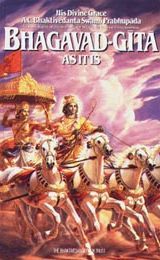
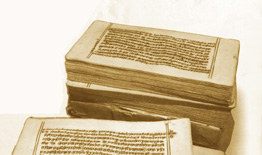
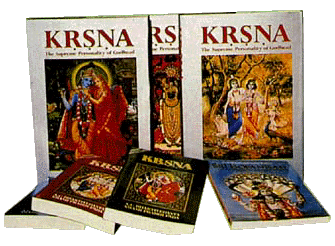
The Complete Works of Srila Prabhupada
All the books, the letters and conversations at your
fingertips
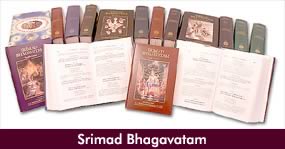

All Srila Prabhupada's books and more on one disk
http://www.vedabase.com




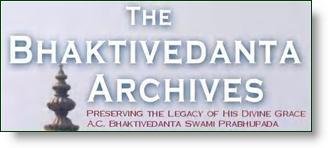
Srila Prabhupada's Audio lectures to listen to on-line:
http://www.hare-krishna.org/srila-prabhupada-lectures.htm
Listen to Srila A.C. Bhaktivedanta Swami Prabhupada on-line
- all 900 of his lectures are available HERE:
http://www.prabhupadavani.org/
Srimad Bhagavatam - the entire lecture series listen and
read along on-line - Narrated by Amala Bhakta dasa:
http://www.prabhupadavani.org/SB_index.html
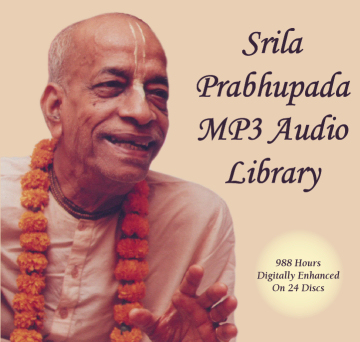
The new enhanced Prabhupada MP3 series
http://www.prabhupada.com/store/store.php?page=product.php&id=MP3AUDIOLIB








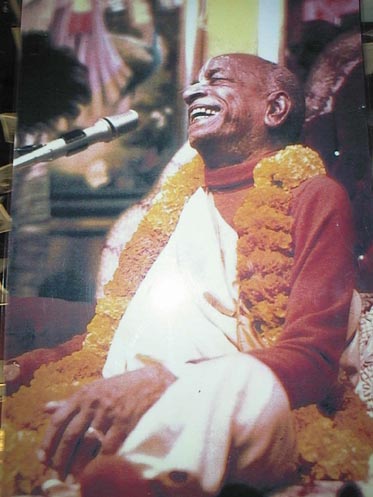
Visit "Prabhupada Connect" for all manner of Prabhupad
Nectar:
http://www.prabhupadaconnect.com/Index.html
Srila Prabhupada's Final Lesson Video - Downloadable and
viewing on-line
http://users.iskconludhiana.com/images/thumbnails.php?album=21


All Srila Prabhupada's original books
available for sale here.

Download all the Hare Krsna teachings which includes
all Vaisnava and
Vedic concepts by visiting one of the sites listed at
the following address.
http://www.geocities.com/suci123/bookdownloadsites1.html
The Bhaktivedanta Book Trust
Srila Prabhupad Memorial Library
http://www.krishna.com/main.php?id=33


33 Books Online Including Srimad Bhagavatam!
http://www.geocities.com/freeprabhupadabooks
The compressed "self extracting" file mentioned is now currently
available for download
http://www.krsnaconsciousness.org/Gauranga/Folio/BhaktivedantaVedabase_DOS.exe

Download or Listen to Prabhupad Bhajans HERE:
http://www.prabhupadavani.org/web/text/Bhajans.html


On-line 1972 McMillan edition - Bhagavad Gita As It Is:
http://www.asitis.com/

Bhagavad Gita AS IT IS on-line through the Tirupathi
Balaji site:
http://www.bhagavad-gita.us/

Bhagavad Gita Study guide on-line book:
http://chantandbehappy.com/gita/studyguide/StudyGuide-main.htm
Bhagavad Gita Study guides by numerous Iskcon devotees
- FREE downloads:
http://www.veda.harekrsna.cz/library/#3

All the Scriptures you'd ever need 4 FREE
http://www.hknet.org.nz/index-books.htm
http://www.hknet.org.nz/DDB.htm
http://www.hknet.org.nz/DDB2.html
last updated 4th August 2003


Srimad Bhagavad Gita AS
IT IS
Bhagavad Gita: Chapter
6 - Dhyana-yoga
TEXT 32
atmaupamyena sarvatra
samam pasyati yo 'rjuna
sukham va yadi va duhkham
sa yogi paramo matah
WORD FOR WORD
atma--with his self; aupamyena--by comparison; sarvatra--everywhere;
samam--equally; pasyati--sees; yah--he who; arjuna--O Arjuna; sukham--happiness;
va--or; yadi--if; va--or; duhkham--distress; sah--such; yogi--a transcendentalist;
paramah--perfect; matah--is considered.
TRANSLATION
He is a perfect yogi who, by comparison to his own self,
sees the true equality of all beings, in both their happiness and their
distress, O Arjuna!
PURPORT by Srila A.C. Bhaktivedanta Swami Prabhupad:
One who is Krsna conscious is a perfect yogi; he is aware
of everyone's happiness and distress by dint of his own personal experience.
The cause of the distress of a living entity is forgetfulness of his relationship
with God. And the cause of happiness is knowing Krsna to be the supreme
enjoyer of all the activities of the human being, the proprietor of all
lands and planets, and the sincerest friend of all living entities. The
perfect yogi knows that the living being who is conditioned by the modes
of material nature is subjected to the threefold material miseries due
to forgetfulness of his relationship with Krsna. And because one in Krsna
consciousness is happy, he tries to distribute the knowledge of Krsna everywhere.
Since the perfect yogi tries to broadcast the importance of becoming Krsna
conscious, he is the best philanthropist in the world, and he is the dearest
servitor of the Lord. Na ca tasman manusyesu kascin me priya-krttamah (Bg.
18.69). In other words, a devotee of the Lord always looks to the welfare
of all living entities, and in this way he is factually the friend of everyone.
He is the best yogi because he does not desire perfection in yoga for his
personal benefit, but tries for others also. He does not envy his fellow
living entities. Here is a contrast between a pure devotee of the Lord
and a yogi interested only in his personal elevation. The yogi who has
withdrawn to a secluded place in order to meditate perfectly may not be
as perfect as a devotee who is trying his best to turn every man toward
Krsna consciousness.
His Divine Grace A.C. Bhaktivedanta Swami Prabhupada
Copyright 1983 The Bhaktivedanta Book Trust International. Used with
permission.

Bhagavad Gita As It Is - http://www.asitis.com/
Bhaktivedanta Vedabase - Bhagavad Gita on-line http://bhagavadgitaasitis.com/
Bhaktivedanta VedaBase: Bhagavad-gita As It Is http://vedabase.net/bg/en
Bhagavad Gita Multi Media Web-version http://chantandbehappy.com/gita/
Listen to Bhagavad Gita on line - http://www.Gitamrta.org
View our Bhagavad Gita Overview:
http://www.hknet.org.nz/BG.html
Archive: http://www.cs.rice.edu/~vivek/btg/archive/
Home Page: http://www.cs.rice.edu/~vivek/btg/
Join Bhagavad Gita eGroups HERE
mailto:bhagavad_gita-owner@egroups.com


Prabhupada Uvacha:
(here's some nectar, sometimes it comes in the form of Srutakirti prabhu's
diary, other times from Govinda dasi's diary, Hari Sauri prabhu's Transcendental
Diary, Bhurijan prabhu's book, or sometimes from a letter, or other related
source, but still nectar...)
His spiritual potency remains unchecked
July 23rd, 1976
Prabhupada called us servants in early this morning
at around 5:00 a.m. He then preached to us until 7:00 a.m. Then, feeling
enlivened, he went to greet the Deities. The devotees were extremely happy
to see him, and he them.
There was, however, one disturbance. As Prabhupada
offered his prostrated obeisances to the beautiful forms of Sri Sri Radha-Gokulananda,
a devotee came forward and touched his feet. Prabhupada was annoyed. When
he got up he stopped his darsana and turned to see who had done it. He
didn't like that it was done in front of the Deities and he warned that
it should not happen again.
He stayed to give class, and it astonished me
how he was able to summon the necessary strength, for he had not eaten
a bite for two days. He continued with the Caitanya-caritamrta verse he
was speaking on in New York. The verse described Lord Krsna's potencies
as inconceivable to the common man, but to the Lord as natural as heat
and light are to fire. For the benefit of his new audience, Prabhupada
brought in the same themes he had preached on so much in America: life
on other planets, and the logic of the mother (nature) and her children
(the living beings) as proof that there is a supreme father.
"We cannot conceive that in the fire also there
can be living entities. And why not? There are five elements, matter. So
if earth is producing life, if water is producing life, if air is producing
life, why not fire? What is the fault there? Everything is producing life.
So the mother produces children. So many children are coming out-tasam
brahma mahad yonih. Yoni means mother. So the children are there, the mother
is there, and where is the father? A common sense. Is there any mother
can produce children without father? Is there any science can prove that
a mother without connection with the father has produced child? No. If
you say, 'I cannot see the father.' You do not see your fathers. There
are many children nowadays who do not know who is father. But that does
not mean there is no father. Common sense. There is father. Similarly,
we see so many living entities produced by the mother, material nature
-- there must be father. And the Father personally says, aham bija-pradah
pita, 'I am the Father.' So why these rascals they say that there is no
God. There must be God, and He has inconceivable potencies. Everything
is being done by Him. If you say nature is doing, nature is a machine.
Nature is not the doer. So less intelligent, for them, it is inconceivable,
but those who are intelligent, they take knowledge from the right source."
He then explained that that source was the Vedas,
also called Veda-mata. "This Krsna consciousness movement is not blind.
Don't think wrongly. We are confident. We sometimes challenge big, big
scientists. On what ground? Not whimsically, but on the ground of sastra.
So we may not please everyone, but we cannot go out of this scope. We know
that in the moon planet, in the Mars planet and all other planets, Jupiter
and others, there are living entities, there is a predominating deity in
each and every planet. Just like Krsna says, imam vivasvate yogam proktavan
aham avyayam. So if there is no living entity in the sun planet, how there
is Vivasvan, the sun-god or the predominating deity in the sun planet.
So we cannot believe this version that there is no living entity in the
sun, moon, or ... There are living entities ... Full of, janakirna, this
word is used -- congested. Just like here in this planet we are congested
-- so many living entities, different varieties. Similarly, the same congestion
is there in all other planets. So do not try to poke your nose [in that]
which is inconceivable. And that also is not assertion. You say, 'Perhaps,'
'Maybe,' 'Millions of years,' 'It might have been' -- all suggestion. So
if you want knowledge, then you have to consult this Vedic knowledge."
He went on to explain that the purpose of the
Vedas was to know Krsna as the Supreme Lord. "In this life one can understand
what is God, what is Krsna. Just like we are trying; that is possible.
But if we do not take advantage of this human form of life to understand
what is God, what is Krsna, then you are lowest of the mankind. And if
we say that 'There are so many doctors of philosophy, doctors of science,
they are also hovering under this darkness, how is that? Then what about
their education?' Yes, their education certainly, but mayayapahrta-jnanah.
The result of education -- knowledge -- that is taken away by maya. Therefore
we should not be washed away by these mudhas' conclusion, naradhamas' conclusion,
mayayapahrta-jnanas' conclusion. We should take up seriously the conclusion
in the sastra, conclusion given by Krsna. Then our life will be successful.
Thank you very much."
His dynamic lecture showed us once again that
Prabhupada's physical condition may be weak, but his spiritual potency
remains unchecked. It is as inconceivable and natural as the Lord's own
energies.
- From the "A Transcendental Diary Vol 3" by HG
Hari Sauri dasa
To receive little snippets of nectar like this on a daily basis subscribe
HERE: or If you want to introduce anyone else in reading Srila Prabhupada
Nectars, please send their eMail addresses to mailto:krpamaya_gauranga@hotmail.com
Please Chant:
 Hare
Krishna Hare Krishna Krishna Krishna Hare Hare
Hare
Krishna Hare Krishna Krishna Krishna Hare Hare
 Hare
Rama Hare Rama Rama Rama Hare Hare
Hare
Rama Hare Rama Rama Rama Hare Hare
...................and be Happy

Listen to Srila Prabhupad on-line
....a different lecture, morning walk, conversation or
class daily.
"Krishna Will Save You"
Srimad-Bhagavatam 1.3.7
September 13, 1972, Los Angeles
Listen to the entire lecture on-line:
http://prabhupadaradio.com/M3U/Bhagavatam/m3u_II/SB067.m3u
Pradyumna: (leads chanting, etc.)
dvitiyam tu bhavayasya
rasatala-gatam mahim
uddharisyann upadatta
yajnesah saukaram vapuh
Translation: "The supreme enjoyer of all sacrifices accepted
the incarnation of a boar, the second incarnation, and for the welfare
of the earth He lifted the earth up from the nether regions of the universe."
Prabhupada: So this universe, this universe is filled
up with water, half. Whatever we are seeing, this is only half, like this.
The other half we cannot see. So within this water, sometimes that Hiranyaksa
demon drowned this whole earth within this water. So at the present moment
we cannot find such demons, but there were demons like that. The whole
planetary system is floating, but there may be some demon who can take
one of them and put within the water. The planets are floating; that is
known to everyone. We can see, actually, that such a big, gigantic mass...
Even the sun, which is fourteen hundred thousand times bigger than this
earth, that is also floating in the outer space. The support is ananta.
They say "law of gravitation"; we say Sankarsana. Sankarsana. So He is
holding every planet, and it is said that all these universes are resting
on the hood of Sesa-naga just like a small grain of mustard.
So when we speak of "God is great," we cannot imagine
how great He is. We apply frog philosophy, Dr. Frog's philosophy. Dr. Frog
thinks, because he is in the well of three feet, if he is given the information,
"Oh, there is a big mass of water, Atlantic Ocean," he cannot believe it.
He will think in terms of the well. The well is three feet. So he may think,
"All right, Atlantic Ocean may be four feet. All right, five feet. Come
on. All right, six feet." So this Dr. Frog's philosophy. The so-called
rascal philosophers and scientists, they are calculating God's creation.
One of the universes is resting on Anantadeva's hood just like a mustard
seed. Not only that...
yasyaika-nisvasita-kalam athavalambya
jivanti loma-vilaja jagad-anda-nathah...
[Bs. 5.48]
Every universe has got a predominating deity, president.
We can understand. In every country, there is a president to rule over
the country. Similarly, to rule over this universe, there is a president.
That is Brahma, Lord Brahma. Lord Brahma's duration of life, span of life,
you cannot calculate. You can calculate, but it is something like beyond
our imagination. His one day is four hundred..., forty-three crores of
years, one day. Similarly, one month, thirty days, one month; then twelve
months, year. Such hundred years. So he lives such hundred years. So that
Brahma lives hundred years in his calculation; that is also a breathing
period of Visnu.
yasyaika-nisvasita-kalam athavalambya
jivanti loma-vilaja jagad-anda-nathah...
[Bs. 5.48]
These gigantic universes, they are coming out from the
hair holes of the body of Maha-Visnu or from His... Just like sometimes
infected persons, they distribute germs from breathing, from perspiration.
That is scientific. Similarly, Maha-Visnu's breathing and perspiration
within the Causal Ocean, bringing forth so many universes. And each and
every universe, there are so many planets, and one of the planets is this,
earth, earthly planet.
So sometimes this earthly planet was thrown into the water,
Garbhodaka-samudra, Garbhodaka Sea, and God took the form of a boar, having
two tusks -- because it was easier. Just like shovel, you take something
like that. So He took the earth. So that is described: ksitir iha vipulatare
tisthati tava... No. What is that? Dasana-sikhare? The, this is described
in Jayadeva's prayer. Vasati dasana-sikhare dharani tava lagna. Vasati,
"is resting"; vasati dasana-sikhare, "on the top of the tusk." Kesava dhrta-sukara-rupa
jaya jagadisa hare. So He's yajnesa. It is not that He's... is shape was
just like hog, but He's not hog. Don't misunderstand. His shape was a gigantic
hog. You can just imagine what kind of hog He was. The shape was like hog,
but He was resting the whole planet, earthly planet, on the tusk. Vasati
dasana-sikhare dharani tava lagna sasini kalanka, kesava dhrta-sukara-rupa.
Here it is stated, saukaram. Saukaram means like hog. Not that He's hog.
He's yajnesa. He can take any shape. Just like here is, God has assumed
the shape of a lion, half-lion, half-man. So He's all powerful, He can
take any shape, any form, but He is not that form. That is for the time
being. For the time being, He assumes so many forms. The real form is Krsna,
the original form. Kesava dhrta-sukara, sukara-rupa or sukara-rupa. "My
Lord Kesava, You have assumed this form."
So there are many millions and millions of forms of God.
According to time, necessity, circumstances, He assumes different forms.
Because it is His business:
yada yada hi dharmasya
glanir bhavati bharata
abhyutthanam adharmasya
tadatmanam srjamy aham
[Bg. 4.7]
He appears as soon as there is discrepancies in the methodical
way. Another place, indrari-vyakulam lokam. Indra. Indra means the heavenly
god, and ari means enemy. So indrari, the enemy of the king of heaven.
That means demons. There are two classes of beings, human being, in the
human state: the devata and asura. So devata means God conscious, Krsna
conscious. Anyone who is Krsna conscious, he is devata, demigod. And anyone
who is not Krsna conscious, he's demon. This is the difference. So that
demon may be very big or small, it doesn't matter, but... Asuras tad-viparyayah.
Viparyayah means "just the opposite." The devotees, they are demigods,
and asura means just the opposite number of devotee; that means nondevotees.
Those who are nondevotees, those who are not devotees of the Lord, they
are all demons.
continued.......................
Listen to the entire lecture on-line:
http://prabhupadaradio.com/M3U/Bhagavatam/m3u_II/SB067.m3u
or receive in mailbox and Subscribe HERE:
mailto:lectures-subscribe@prabhupadavani.org
Sravanam kirtanam at:
http://www.PrabhupadaVani.org
© 2001 The Bhaktivedanta Book Trust International. Used with permission.

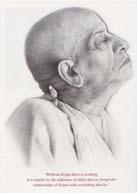
SRILA PRABHUPADA'S QUOTE OF THE DAY
He is visible, but we cannot see. So we take asrayah, shelter of His
devotee.
Therefore Srila Rupa Gosvami gives his formula how to become attached
to Krsna. First he says, adau sraddha. First of all, faith, the beginning.
Just like you have come very kindly to this temple with some faith
that "Here is the Krsna consciousness movement.
Bhagavad Gita. London Lecture 1975
Sign-up to receive these quote HERE:
mailto:haribol@pacific.net.sg

Bhaktivedanta Vedabase Network ...
http://vedabase.net/


The Scientific - Mathematical
Proof for God's existence:
http://geocities.com/sector114
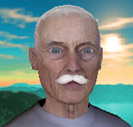
http://robot-hosting.com/php/login_nicholas.html
user name = guest
password = guest
(Collection of philosophical and mathematical proofs
for existence of God can be found in this site.)

Scientifically Philosophical Books for the layman
 ...
...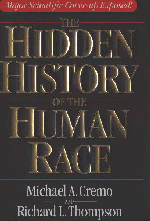 ...
...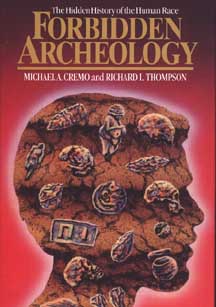 ...
...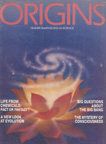
Click on any of these books to read more about them and where to get
a copy
or contact your local temple for purchases
sample of Life
comes from Life HERE.pdf

Lotus Imprints - Preserving Prabhupada's Legacy - The
Publishing House of Hari Sauri dasa
http://www.lotusimprints.com/

Quotes from Shastra - scriptures
View using Balaram font
"The Cäturmäsya period
begins in the month of Äñäòha (June-July) from
the day of Ekädaçé called Çayanä-ekädaçé,
in the fortnight of the waxing moon. The period ends in the month of Kärtika
(October-November) on the Ekädaçé day known as Utthänä-ekädaçé,
in the fortnight of the waxing moon. This four-month period is known as
Cäturmäsya. Some Vaiñëavas also observe it from the
full-moon day of Äñäòha until the full-moon day
of Kärtika. That is also a period of four months. This period, calculated
by the lunar months, is called Cäturmäsya, but others also observe
Cäturmäsya according to the solar month from Çrävaëa
to Kärtika. The whole period, either lunar or solar, takes place during
the rainy season. Cäturmäsya should be observed by all sections
of the population. It does not matter whether one is a gåhastha or
a sannyäsé. The observance is obligatory for all äçramas.
The real purpose behind the vow taken during these four months is to minimize
the quantity of sense gratification. This is not very difficult. In the
month of Çrävaëa one should not eat spinach, in the month
of Bhädra one should not eat yogurt, and in the month of Äçvina
one should not drink milk. One should not eat fish or other nonvegetarian
food during the month of Kärtika. A nonvegetarian diet means fish
and meat. Similarly, masüra dhal and urad dhal are also considered
nonvegetarian. These two dhals contain a great amount of protein, and food
rich in protein is considered nonvegetarian. On the whole, during the four-month
period of Cäturmäsya one should practice giving up all food intended
for sense enjoyment."
Sri Chaitanya Charitamritam Madhya
lila 4:169 purport.

The Chaturmasya Vrata from Haribhakti Vilasa
15th vilasa
Caturmasya Benefits
Bhavisya Purana- "One who passes the Chaturmasya
season without observing religious vows, austerities and chanting of japa,
such a fool although living should be considered to be a dead man."
Kanda Purana, Nagava Khunda- "In the month of shravana
(July, August) one should refrain from eating spinach. In the month
of Bhadra (August, September) of yogert in Ashvina (September, October)
milk. In Kartik (October, November) meat and urd dall.
Various vows and austerities during Chaturmasya and Their
respective results.
"O King, one who is My devotee and is fixed in vow, whether
man or woman, for the purpose of Dharma, should accept these various austerities
and observances. I shall now describe to you all of them along with their
respective results.
1) No salt—One's voice becomes sweet.
2) No oil—One's life is prolonged and gets progeny.
3) No oil massages—One's body becomes beautiful.
4) No cooking with oil—One's enemies are vanished.
5) No licorice and oil—One becomes wealthy.
6) Give up wearing unoffered flowers—One becomes a Vidyadhara
in Devapura.
7) Give up six kinds of tastes (spice, sour, bitter,
sweet, salty and harsh)—One never becomes ugly, smelly, or obtains a bad
birth.
8) Practice of yoga—One goes to Brahmaloka.
9) No betal nuts—One becomes happy.
10) No cooked food (raw fruits & Vegetables)—One
obtains purity.
11) No honey—One becomes lustrous.
12) No yogert or milk—One attains Goloka.
13) No cooking with earthen pots—One gets ... (?)
14) No hot food—One gets offspring with a long life.
15) Take rest on the ground or on stone—One becomes an
associate of Vishnu.
16) One who gives up meat & honey is a yogi and muni.
17) No intoxicating liquors—One becomes powerful and
free from disease.
18) Fast for one day—One is honored in Brahmaloka.
19) No cutting of hair and nails—One gets the benefit
of taking bath daily in Ganges.
20) No speaking of grama katha (nonsense)—One's order
will never be disobeyed.
21) Eat food on the ground without dish or plate—One
obtains a kingdom on Earth.
22) Chant the mantra Namo Narayana—One obtains the result
of giving in charity 100 times.
23) Offer prayers to the Lord—One gets the result of
giving cows in charity.
24) Touch the lotus feet of the Deity—One becomes a successful
person.
25) Clean the temple of the Lord—If one is king he remains
so for a Kalpa.
26) Circumambulating the temple three times offering
prayers—At the time of death one will mount a swan airplane and go to Vaikuntha.
27) Singing or playing musical instruments in the temple
of the Lord—One goes to Gardharvaloka.
28) Take pleasure in studying the sastras—One goes to
Vishnuloka.
29) Sprinkle water in the temple—One goes to apsaraloka.
30) Take bath in a holy place—One's body becomes pure.
31) Worship Lord Vishnu with flowers—One goes to Vaikuntha.
32) Eat panchagavya—One gets the result of observing
candrayana fasting.
33) Eat one meal a day—One gets the results of performing
an Agnihotra.
34) Eat at night only—One gets the result of going to
all the places of pilgrimage.
35) Eat at noon only—One attains Devaloka.
36) Take food not obtained by begging or any extraneous
endeavor—One gets the results of opening water stands and digging wells.
37) Take bath daily—One will never see hell.
38) No eating on a plate—One gets the result of bathing
at Pushkara
39) Eat on a leaf—One obtains the result of living at
Kurukshetra.
40) Eat on a stone—One obtains the result of bathing
at Prayog.
41) Giving up drinking to six hours—One will not be attacked
by diseases.
42) During the Chaturmasya, garlands, caranamrta, candana
and water from the conshell of the Lord, mahaprasädam, Deity garlands
must be accepted.
In this way one who performs this vrata for the satisfaction
of Lord Kesava becomes satisfied himself. O best of the Pandavas, among
My devotees, he who accepts these vows and austerities during the Chaturmasya
goes to my abode at the time of death, of this there is no doubt.
Vishnu Rahasya- Lord Brahma to Narada Muni.
If one accepts all these Vaisnava austerities and
observances with devotion, one attains the supreme destination O Narada.
One who desires within himself to execute all these Vaisnava austerities
and vows, his sins obtained within one hundred births is destroyed. If
one is exclusively devoted, peaceful, takes daily bath, is fixed in vow
and worships the Lord during these four months, he goes to the abode of
the Lord. He who accepts the austerity of sleeping on the ground this time
when the Vishnu Deity is sleeping in yoga nidra underwater, he goes to
the abode of Laxmi.
Read more about vrata, sankalpa and Chaturmasya in general
HERE
Chaturmasya-info-Madhwas.html
Chaturmasya-vrata.html

The vows of Chaturmasya and Kartika are not optional, but should be
observed by all, as noted in Hari-bhakti-vilasa (16.19):
niyamena vinA caiva yo nayet kArttikaM mune |
cAturmAsyaM tathA caiva brahma-hA sa kulAdhamaH ||
"He, who lives through the periods of Karttika and Chaturmasya without
vows is indeed the killer of a brahmin and the lowest of his dynasty."
Jiva Goswami quotes (BhS 270) on the best of austerities from the Caturmasya
Mahatmyam of Skanda Purana:
tathA caivottamaM loke tapaH zrI-hari-kIrtanam |
kalau yuge vizeSeNa viSNu-prItyai samAcaret ||
"Certainly in this world, the best of all austerities is Sri Hari-kirtana.
Especially in the age of Kali, it is to be done for the satisfaction of
Vishnu."
Many householders, busy as they are in their daily routines and work,
may not find the time for kirtan every day. In the four months of Chaturmasya,
one should, as the most important of all vows, endeavor to engage daily
in kirtan. If the Lord is not glorified and remembered, of what use are
the varieties of ritual observances, of which the primary intent is to
prepare the mind for those very activities?


SRI SRI RADHA GOVINDA'S JHULAN YATRA
To view this page you will need the Balaram FONT
installed on your system
SRI JHULAN YATRA
One of the most popular events in
the holy town of Vrindavan,
India - where Lord Krishna appeared 5,000 years ago - is the celebration
of Jhulan Yatra, the Radha-Krishna swing festival. In Vrindavan among the
local villagers and inhabitants this festival lasts for 13 days. In Vrindavan
this is one of the biggest festivals of the year and Vrindavana is very
crowded at this time, literally hundreds of thousands of people from surrounding
towns and villages visit Vrindavan over this period in the auspicious sacred
month of Shravana (July-Aug). Opulence or simplicity, but often the swings
are made of gold or silver.
In Sri Vrindavan for five days, in
many of the 5000 temples there, the small Utsav-vighraha functional Deities
(Vijay-utsav bera) are taken from the altar and placed on an elaborately
decorated swing in the temple room. After receiving the traditional arati
worship, the Deities are pushed on Their swing. Members of the congregation
are invited to participate. Each person offers flower petals and personal
prayers, and then pushes the swing several times as the other members chant
Hare Krishna, Jaya Radhe Jaya Krishna jaya Vrindavan, or Jaya Radhe, Jaya
Jaya Madhava dayite in kirtan. The atmosphere of this festival is especially
sweet as everyone has the chance to intimately serve Radha and Krishna.
The same festival
is observed in other parts of India too in this sacred month of Shravana.
For example in Jagannath Puri, for the pleasure of Lord Jagannath's utsav
vighraha (Madan-mohan ji, this festival is celebrated from Shravana Shukla
Dashami (10th Tithi/phase of the Moon of the light fortnight) until Pratipada
(1st tithi of the dark), a period of seven days. Sri Madanmohan, Jagannath's
representative deity (vijay utsav), as well as Laxmi and Vishwadhatri are
placed on a decorative wooden swing on Muktimandap (Jhulanmandap). There,
worshippers have a chance to swing the Lord, thus entering into His pastimes.
On the day of the full moon (Gamha Purnima or Jhulan Purnima), Lord Balabhadra's
appearance day is celebrated.
In Vrindavan it starts on the Tritya
(third day) of the bright fortnight of Shravana and lasts until the full
moon night of the month. During this festival the Radha-Krishna Deities
in the temples are swung on a swing. Some of the main temples
that this festival is celebrated at are the Banke Bihari Temple and the
Radha-Raman Temple in Vrindavana, the Dwarkadish temple in Mathura, and
the Larily Lal Temple in Varsana.
In
our Iskcon temples we observe for five days in accordance with Srila
Prabhupada's instructions (HERE). So whether one
observes for the four days or for the seven, or thirteen days, the same
festival is put on for the pleasure of the Lord and His loving associates.
This is a wonderful ceremonial function
of Lord Krishna's pastimes that reflects practically how we are to render
service to the Lord for His pleasure.
At the time of the Jhulan Yatra festival
it is Monsoon in India and the air is thick, heavy and humid with the heat
and the rains. In the midst of the rainy season, when fields and jungle
have turned shades of lush green and flowers are blossoming all around,
the festival of Hariyali Teej is celebrated.
These festivals are not in any way
mere rituals, as they all have practical service functionality to invoke
loving servitude of the devotees for the Lord. Lord Sri Krishna is the
Supreme enjoyer and doesn't have to work hard like us in this world. Everything
He does is pleasurable, and He organises many situation in which He can
incorporate us, His separated parts and parcels into His loving service
which is our natural condition in the spiritual realm.
When Sri Krishna had his pastimes
in rural Vrindavan with His cowherd friends together they lovingly tended
the cows, and wandered in the pastures playing, frolicking, and feasting.
Throughout the various seasons they all continuously enjoyed being part
of Sri Krishna's pastimes, and rendering loving service to Him as best
they could.
Over the past few months as the climate
had changed from Vasant Panchami (Spring festival) where everyone dresses
in yellow and goes to the fields, performs fertility rites, and plants
new crops, etc.) to Dola Purnima where scented powders and flowers are
thrown on the body of the Lord playfully, and singing and dancing goes
on for His pleasure. Similarly all the other different festivals were observed
where the friends of Lord Krishna would look after His express comforts
or pleasure, go to the forest with Him, serve Him and have fun.
As the temperature rises toward Summer
the Chandan Yatra is performed where from the Akshaya Tritiya for a period
of 21 days the body of the Lord is anointed with scented sandalwood mixed
with camphor, musk, saffron. As the sandalwood is applied to the body it
immediately cools, but then there is a natural cycle that also follows
with the heat naturally there is some perspiration, and as the perspiration
again mixes with the sandalwood it is dried and cooled by even the slightest
breeze creating a pleasant feeling like being covered with Talcum powder.
However, as the temperature increases
just to be anointed with something cooling is not enough therefore on (or
from for some sampradayas or temples) the Snan Purnima in the month of
Jyestha (Trivikram Vaishnava mase) there is the ceremonial bathing of the
Lord called Snan Yatra. Although it has become especially festive in Jagannath
Puri the actual event originates in Vrindavana with the devotees bathing
Krishna, and Balaram for their pleasure and then taking bath themselves
too. Actually at this time there is no other solace than to bathe in some
kind of pleasing water. All the temples of Vrindavan follow this festival,
and many devotees follow a trail of pilgrimage from one temple to the next
from early morning to late evening when the temperature lowers to about
35-40 degrees centigrade absorbed in the Snan rasa.
The next major interactive event
is Rathyatra where the devotees symbolically bring Lord Krishna (Jagannath)
His brother Balaram and Subhadra maharani on high chariots, with beautiful
flapping canopies, back to rural Vrindavan after their spell in Kurukshetra.
After this comes the Jhulan Yatra
festival. Starting on the ekadasi of waxing moon of Sridhara month, many
temples in Vrndavana celebrate Krsna's swing festival, some for one day,
others for more days. Traditionally many of the Deities of the Lord wears
various clothing with green in it over this period until the Balaram Purnima.
Again it is a practical festive service that the devotees provide for the
Lord. Monsoon is so humid, and the temperature is still so hot despite
the cooling rains. With so much water coming from the sky, on the ground,
and just about everywhere the last thing that anyone wants is more water
to cool off. The opulence at this time is to find a breeze, as the air
is heavy with the humidity of the rains. So the devotees arrange for the
pleasure and satisfaction of Krishna, Balaram, and Srimati Radhika by placing
them on a swing (Jhulan) and creating their own breeze from the motion.
It is a most pleasing and satisfying
festival, with the swings often highly decorated with forest creepers,
Jasmine (Malati) that has newly blossomed in the season, and streamers
of garlands. Sometimes they use a fine spray of rose water and direct it
toward the Divine couple of Radha and Krishna on Their swing.
Today in Iskcon temples all over
the world by the mercy of his Divine Grace Srila A.C. Bhaktivedanta Swami
Prabhupad all the devotees and the congregational members get the opportunity
to come forward after purifying their hands and remember these loving interactions
of Sri Krishna with His devotees, and also assist in the direct personal
service of the Lord by applying themselves to pushing the swing.
On the last day of the Jhulan, on
the Purnima (full moon) this comes Lord Balaram's appearance day festival.
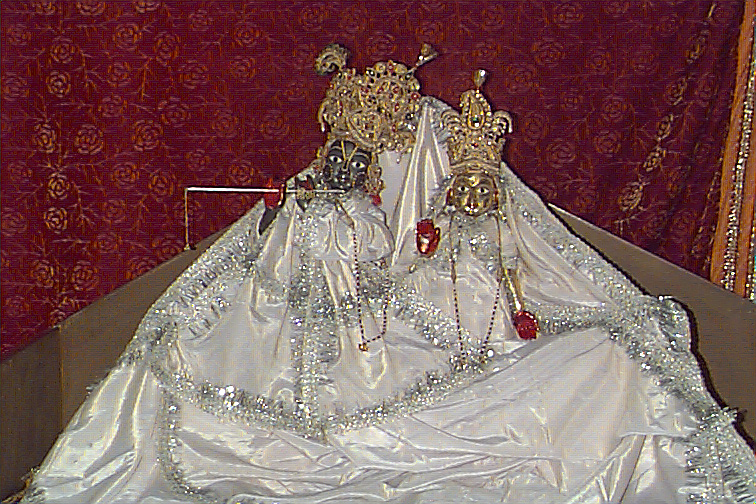
Sri Sri Radha Shyamasundara from Varshana, Vraj mandal
Jhulan references:
"Regarding
Jhulanayatra Ceremony, during these five days the Deities' clothing should
be changed everyday, and there should be nice Prasadam distribution and
Sankirtana as far as possible. If you are able to do it, a nice throne
may be constructed on which the Deities can be placed. This throne may
be swung gently during Kirtana. That will be very good, and surely the
Deities will enjoy the function." (A.C. Bhaktivedanta Swami Prabhupada.1st
August. 1969. Letter to Jayapataka Swami. Letters book pg. 977.)
"So we have to practice this Krsna
consciousness. Here, in this material world, we have to work. Without work,
you cannot maintain even your family, your body. That is not possible.
Sarira-yatrapi te na prasiddhyed akarmana-. Krsna says (to) Arjuna that
without karma you cannot maintain even your body. So you have to work.
Sarira-yatrapi te na prasiddhyed akarmana-. And this material world means
you have to maintain by working. And spiritual world means na tasya karyam
karanam ca vidyate. There is nothing to work, as Krsna has nothing to work.
He is simply enjoying What is called? Swing. So Krsna is enjoying, and
Krsna's associates are enjoying. They have nothing to work. That is spiritual
world. Cintamani prakara sadmasu kalpa vrksa: that is a different world.
There is no material body. Therefore there is no need of the material body.
That is a different world. But in this material world we have to work.
Trt'ya-karma-samj<anya avidya-karma-samjanya trtiya aktir isyate. This
material world means you have to work and adjust things for your maintenance.
That you cannot escape. But still, we have to become Krsna conscious" (A.C.
Bhaktivedanta Swami Prabhupada. 10th August 1976. Srimad Bhagavatam 3:22:21.
Tehran, Iran.)
"Radha and Krsna may be swung in
this way, but you may avoid swinging Lord Jagannatha like that."(A.C. Bhaktivedanta
Swami Prabhupada. 5th Jan. 1973. Letter to Jagdish. Letters book p.2220.)

Some special nectar
from the Chronicals of Srila Bhaktivindoa Thakur,
he tells of some of his experience of feasting during Jhulan yatra.
A pastime of Srimati Radharani
and Sri Krishna's:
As stated Jhulan-yatra is very dear
to Krsna, He likes it very much, now from another perspective you will
see why !!!. From a cultural perspective in India during this period, all
daughters go to their father's house to stay there for some days and enjoy
the swing festival - a custom celebrated even up to this day.
Every year Srimati Radharani used
to go to Varshana to her parents' house and have a very nice time there
with her Gopi friends and Krsna, whom She could freely meet (because Jotila
and Kotila were not around).
'One time Radharani was waiting for
her brother Sridam to come and take her to her fathers' house. She was
waiting, waiting, and waiting, but there was no sign of Sridam and She
became so sad. One day a person from Varsana was there. She asked the man
to ask her father, "Why have they have forgotten Me?" She then started
to cry bitterly. The person went to Varshana and told Vrsabhanu Maharaja
about the condition of his daughter. Hearing this news, Vrishabhanu Maharaja
immediately sent Sridam to Varshana to get Radharani.
Srimati Radharani's Mother Kirtida
packed many presents for Jotila to send with Sridam, knowing that if she
did not do this, Jotila, being harsh of character sometimes would not send
Srimati Radharani to Varshana.
Meanwhile, day and night Srimati
Radharani was staring at the road coming from Varshana. One day, She saw
Sridam and when he finally arrived at the front gate they embraced each
other. She was weeping, "Oh brother you had forgotten Me?; My father and
mother too?; Everyone forgot Me?"
At first Jotila refused to let Srimati
Radharani go. "No no, She cannot go. She has so much work to do here, and
there is so much danger there because of that black boy. She cannot go."
Then Sridam gave Jotila all the presents
given by Kirtida ma. Seeing this, she said, "Alright, she can go, but only
for a few days."
"Then Srimati Radharani and Sridam
went on a cart pulled by four bullocks to Varshana. Seeing the palace of
her parents on the hilltop, feeling great happiness Radharani started weeping
and even more weeping when She saw Her father and mother face to face.
 At that time Jhulan-yatra had already
started and Srimati Radharani started swinging with Her sakhis (friends)
during periods in the day and night, but She was not satisfied alone, without
Krsna there. Knowing this, Krsna sometimes came in disguise to the palace.
Sometimes He dressed as a Gopi selling bangles or beautiful garlands. Or
He appeared in any other form and made an appointment for Them to meet
each other somewhere in a very secret place in the forest.
At that time Jhulan-yatra had already
started and Srimati Radharani started swinging with Her sakhis (friends)
during periods in the day and night, but She was not satisfied alone, without
Krsna there. Knowing this, Krsna sometimes came in disguise to the palace.
Sometimes He dressed as a Gopi selling bangles or beautiful garlands. Or
He appeared in any other form and made an appointment for Them to meet
each other somewhere in a very secret place in the forest.
Once, Srimati Radharani was seated
on the Jhulan and Krsna was pushing the swing very gently. Suddenly Krsna
put so much force in pushing the swing that Srimati Radharani became fearful
and started crying out, "O Krsna, save Me, save Me!" That transcendental
trickster Sri Krsna climbed on the swing and She firmly embraced Him, giving
Him so much pleasure. Why so much pleasure? Because normally He has to
do so many tricks so that Radharani will embrace Him, but in this instance
She embraced Him out of Her own will, without much effort on His part.
Therefore He is so fond of these swing pastimes.
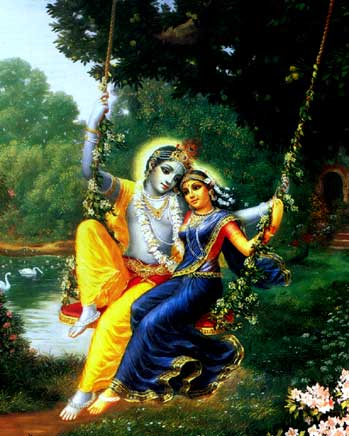
Pictures of Srimati
Radharani's home and palace at Varshana, and some of the wonderful parks,
walkways and garden where Radha and Krsna had so much fun andloving exchanges
can be viewed HERE.
Some meditations on Sri Jhulan
Yatra in Sri Vrindavan Dham.
The Jhulan time is very intense.
In general the Shravana masha have an exceptional mood, it is raining all
the time, Yamuna Mayi became very wide, flooded and there is a fresh atmosphere
for devotees who move daily to whorship and take the lila-darshan which
is performed in diverse temples in Vrindavan. As an example, in Jai Sing
Geera, the lilas are performed during the whole week: every morning Gauranga-lila
and at the evening Krishna-lila's theatre is played.
Devotees tell that some time ago
a king, who was a great devotee of Sri Radha-Raman
used to came to Vrindavan in the Shravana month to assist that performances
which started out of his own desire. The rasa-lilas and theatre performance
of Sri Gauranga Mahaprabhu and Sri Krishna lilas was very dear to him and
surely to Sri Radha Krishna also because since that time it now takes place
as a yearly event.
In each of Vrindavans' temples a
wonderful swing-kunja is to be found, each with singular features along
with the swinging mood and the always happy "Jay Sri Radhe! Jay Sri Radhe!".
There took place also the golden swing darshan of Sri Banka Bihari ji,
which occurs once yearly. It happen the first day of Jhulan in which streets
are completely crowded, any vehicles, like cars, even Auto-rickshaws transit
is very much restricted and Rikshaws can move only in the main roads. Some
devotees wait until the midnight special aratis to get darshan because
during the day it's just ridiculous to try and get in with the hundreds
of thousands of villages who descend on Vrindavan township to be absorbed
in this wonderful festival.
There's a good business made by devotees
engaged in making the huge amounts of garlands that are used in all the
temples, by all the devotees wanting to offer garlands, and to decorate
the temples and Jhulan(s) during the whole week. It's a perfect example
how everyone benefits, both economically - financially, socially, spiritually
etc., simply by rendering some simple service for the pleasure of the Lord.
Vast amounts of prasadam is cooked and offered to the Deities, and sold
for a small donation; the hotles, dharmshallas, guest-houses etc, Rickshaws,
taxis, everyone, all are happy and satisfied knowing that simply by serving
the Lord, the root of everything all their needs will be taken care of.
more nectar HERE

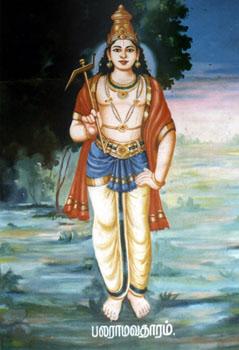
Lord Balarama
Who is Lord Balarama?
*****************
The Supreme Personality of Godhead, Krishna, is the fountainhead
of all incarnations. Lord Balarama is His second body. They are both one
and the same identity. They differ only in form. Balarama is the first
bodily expansion of Krishna, and He assists in Lord Krishna's transcendental
pastimes. He is the source of the entire spiritual world and is the adi-guru,
the original spiritual master.
He assumes five other forms to serve Lord Krishna. He Himself helps
in the pastimes of Lord Krishna, and He does the work of creation in four
other forms called the catur-vyuha (four armed) forms known as Vasudeva,
Sankarshana, Pradyumna and Anirudha. He executes the orders of Lord Krishna
in the work of creation, and in the form of Lord Sesa He serves Sri Krishna
in various ways. In all the forms He tastes the transcendental bliss of
serving Krishna. No one can approach Krishna without first getting the
mercy of Baladeva.
Descent of Balarama
****************
Whenever Krishna appears in the material world, He is accompanied by
His associates and paraphernalia. Five thousand years ago when Krishna
descended into the material world, He was first preceded by Baladeva. Only
after Baladeva give His mercy did Krishna descend, such is the intimate
relationship between Krishna and Baladeva.
When Baladeva appeared as the seventh child in the womb of Devaki, she
could understand that this was a divine child and this made her all the
more concerned about His safety. Even Kamsa could sense His potency and
he became fearful, thinking he may have been tricked by the prophecy that
he will be slain only by the eight child of Devaki. At this time Krishna
instructed Yogamaya, His internal potency, to transfer the unborn child
from the womb of Devaki to that of Rohini, one of the other wives of Vasudeva,
who was hiding from Kamsa in the house of Nanda Maharaja in Gokul.
In this way Balarama was born in Gokul under the protection of Nanda
Maharaja. Garga Muni the venerable kulguru (family priest) of the Yadu
dynasty revealed to Rohini that the child she was carrying was indeed that
of her husband Vasudeva. At the time of the name-giving ceremony he named
the child Rama, one who gives all pleasures. Referring to the immense strength
of the child, Garga Muni predicted that He will also be known as Balarama
(bala meaning strength). Since He was forcibly attracted from the womb
of Devaki to that of Rohini, He was also be called Sankarshana. As the
son of Rohini He was known as Rohini-nandan and as the elder brother of
Krishna He was also called Douji.
The form of Lord Balarama
********************
Powerful Lord Balarama is sixteen years old, full of the luster of
youth and has a fair complexion the color of crystal. He wears blue garments
and a garland of forest flowers. His handsome hair is tied in a graceful
topknot. Splendid earrings adorn His ears and His neck is splendidly decorated
with garlands of flowers and strings of jewels. Splendid armlets and bracelets
ornament Douji's graceful and very strong arms and His feet are decorated
with splendid jeweled anklets.
Lord Balarama's beauty is enhanced by the earrings touching His cheeks.
His face is decorated with tilaka made from musk, and His broad chest is
ornamented with a garland of gunja. Balarama’s voice is very grave and
His arms are very long, touching His thighs
The splendor of Lord Balarama's transcendental form eclipses many millions
of glistening rising moons, and the slightest scent of His boundless strength
is sufficient to destroy many armies of demons. Although He knows the supernatural
power of His younger brother, Krishna, still, out of love for Him, He never
leaves Krishna alone in the forest even for a moment. Balarama is Sri Krishna's
dearest friend and is a great reservoir of the nectar mellows of many kinds
of transcendental pastimes.
Specific Pastimes of Lord Balarama
Balarama slays Dhenukasura
*********************
Dhenukasura was a powerful demon who had assumed the form of an ass.
With his demon friends he was occupying Talavana, one of the twelve forests
of Vrindavana. Out of fear of these demons no one could approach Talavana
and enjoy the numerous flowers and fruits in the forest. Balarama, induced
by His cowherd friends, entered the forest desiring to kill the demons.
He began shaking the fruit trees, making a big noise. Dhenuka, furious
at the intrusion, attacked Balarama with his rear legs, but Balarama easily
picked him up by his legs and whirled him around until he died. As the
other demon friends of Dhenuka rushed to attack, Krishna and Balarama picked
them up and threw them on trees, killing them. Soon the forest was free
of all demons, and it appeared that the bent trees were being directed
by Balarama to pay obeisances to Krishna.
Balarama kills Pralambasura
********************
Once when Krishna and Balarama were playing with the cowherd boys,
a demon named Pralamba entered their midst, disguised as a cowherd boy.
Understanding the invincible potency of Krishna, he instead decided to
abduct Balarama. At the end of the game, as the losing party he was supposed
to carry Balarama on his shoulders. Carrying the Lord on his shoulders
he ran swiftly, but Balarama realizing the true identity of demon began
to make himself heavier and heavier. Unable to bear the weight, the demon
assumed his original form which was like a huge dark effulgent cloud, decorated
with golden ornaments. Balarama then bought His fist down the head of the
demon splitting it into two and causing him to give up his life.
Balarama glorified by Krishna
**********************
As the elder brother of Krishna, Balarama was the object of His love
and respect. Once when walking in the forest of Vrindavana, Krishna observed
the trees bending down as if paying obeisances. He glorified the lotus
feet of Balarama as being the object of devotion even for the demigods.
He said that the trees, which were impersonalists in previous life times,
witnessing the personal form of Balarama were now praying for His devotion.
At other times when Balarama would get tired by playing, He would lie down
the lap of one of the cowherd boys and Krishna would personally massage
His feet, fan Him and give Him service. Such was the sweet reciprocation
of love between Krishna and Balarama.
Yamuna devi chastised
******************
Once Lord Balarama, Who was at the time living in Dwarka, came back
to stay in Vrindavana for two months. At this time He enjoyed pastimes
with His gopi friends (who were different from the gopis of Krishna). Enjoying
such pastimes on the bank of Yamuna at Rama-ghata, the Lord summoned Yamuna
so that He could sport in the waters. When Yamuna devi did not respond.
Lord Balarama took up His favorite weapon, His plow, and began to drag
Yamuna in a hundred streams. Understanding the position of Balarama, Yamuna
devi personally appeared and offered her obeisances to the Lord with many
prayers in His glorification. Thus appeased the Lord entered and bathed
in the waters of the river.
Kauravas chastised
***************
Samba, the darling son of Jambavati and Krishna, kidnapped Laksmana
the daughter of Duryodhana from the assembly were she was supposed to choose
her husband. The furious Kauravas after a prolonged fight, finally arrested
Samba by sending in six of their greatest warriors. When the Yadavas heard
of this they prepared for battle but Lord Balarama pacified them, preferring
to find a peaceful solution. However when He requested the Kauravas to
return Samba and Laksmana, the Kauravas responded by insulting Him and
the Yadava dynasty. Understanding them to be ignorant in their false prestige,
Balarama took His plow and began to drag Hastinapura into the Ganges. The
terrified Kauravas now surrendered to the lotus feet of Balarama, begging
for His mercy. They immediately returned Samba and Laksmana and had them
married ceremoniously with many opulent gifts.
Balarama marries Revati
******************
In Satya yuga there was a King named Raivata whose daughter Revati
was excellent in all respects. Unable to find a match suitable for her,
the king took her to the court of Brahma for his advise. After waiting
for some time when the king met with Brahma, he was shocked to learn that
in the short time he spent in the Brahmaloka, millions of years had already
passed on Earth and at the time Dvapara yuga was concluding. However Lord
Brahma informed King Raivata that present at this time was Lord Balarama
Who was more than qualified to be the husband of Revati.
King Raivata returned and approached Balarama to accept Revati as His
wife. However Revati belonged to an earlier yuga when people were much
larger physically. So Lord Balarama placed His plow on her head until she
shrunk to an appropriate size and accepted her as His wife.
Balarama and Mahabharata
*********************
In general Balarama was equally affectionate to both the Pandavas and
the Kauravas. He accepted both Duryodhana and Bhima as His disciples in
the art of mace-war. As a teacher He appreciated the superior technique
of Duryodhana as opposed to the raw strength of Bhima. At the time of Mahabharata,
He refused to take sides and instead went on an extended pilgrimage to
the holy places. In the battle between Bhima and Duryodhana, He became
angry at Bhima for killing Duryodhana by trickery, but was appeased by
Sri Krishna.
Killing of Romaharshana
******************
Towards the end of Dvapara yuga thousands of sages assembled on the
banks of Naimyasharana to perform a thousand year yajna in an effort to
reverse the onset of Kali yuga. They appointed as their leader Romaharshana,
one of the main disciple of Vyasadeva, who was also present when Sukadeva
Goswami narrated Srimad Bhagavatam to King Parikshit.
When Lord Balarama entered the assembly, understanding Him to be the
Supreme Personality of Godhead, all present rose to offer Him respect.
However Romaharshana, proud at occupying the position of the leader did
not get up. Lord Balarama could understand that even though Romaharshana
was a an expert Vedantist, he had not yet realized these teachings. Considering
him unqualified to lead the ceremony, Balarama touched him with a blade
of grass causing him to die. He then instituted Suta, the son of Romaharshana
as the leader of the assembly and continued with His pilgrimage.
The Mercy of Lord Balarama
******************
Lord Balarama exemplifies the service attitude to Krishna. His only
mission is to please Krishna by rendering service to Him, whether it is
in the creation of the material worlds, maintaining the spiritual world
or as His personal paraphernalia.
Lord Balarama is the eternal companion of Sri Krishna. He came as Lakshmana
with Rama and later as Nityananda Prabhu with Caitanya Mahaprabhu. He is
the original spiritual master, and any one desiring to make spiritual progress
must first get the mercy of Lord Balarama.
All glories to Lord Balarama !!
Reference : Srimad Bhagavatam, Tenth Canto.
Read more about Lord Balaram HERE

All pictures from Srimad Bhagavatam and Iskcon works - Copyright ©2005
The Bhaktivedanta Book Trust
International, on the web at .http://www.krishna.com/.
Used with permission.









![]()
![]()
![]()

![]()
![]()
![]()
![]()

![]()
![]()
![]()
![]()



















